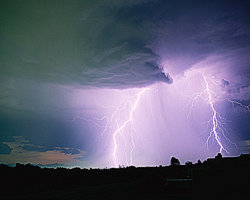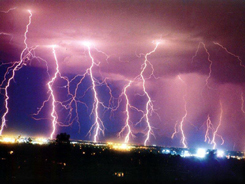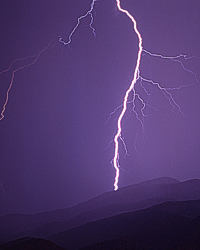
Lightning is the MOST UNDERRATED weather hazard. On average, only floods kill more people. Lightning makes every single thunderstorm a potential killer, whether the storm produces one single bolt or ten thousand bolts.
In the United States, lightning routinely kills more people each year than tornadoes and hurricanes COMBINED. Tornadoes, hail, and wind gusts get the most attention, but only lightning can strike outside the storm itself. Lightning is the first thunderstorm hazard to arrive and the last to leave.
Lightning is one of the most capricious and unpredictable characteristics of a thunderstorm. Because of this, no one can guarantee an individual or group absolute protection from lightning. However, knowing and following proven lightning safety guidelines can greatly reduce the risk of injury or death. Remember, YOU are ultimately responsible for your personal safety, and should take appropriate action when threatened by lightning.
While no place is 100% safe from lightning, some places are much safer than others.
Lightning Safety Plan
A lightning safety plan should be an integral part of the planning process for any outdoor event. Do not wait for storm clouds to develop before considering what to do should lightning threaten! An effective plan begins LONG before any lightning threat is realized. You can't control the weather, so you have to work around it!
Detailed weather forecasts are accurate only out to seven days at best, but outdoor events often are planned many months in advance. Because of this limitation, every outdoor event coordinator should consider the possibility of lightning, especially if the event is scheduled during the late spring to early autumn months.
The key to an effective lightning safety action plan lies in your answers to the following questions:
- Where is the safest lightning shelter?
- How far am I (or the group I am responsible for) from that location?
- How long will it take me (or my group) to get there?
Knowing the answers to these questions will greatly reduce your chances of being struck by lightning, provided you know them BEFORE thunderstorms threaten
The 30/30 Rule

Any lightning safety plan should incorporate the 30/30 Rule. The 30/30 Rule states that people should seek shelter if the "Flash-To-Bang" delay (length of time in seconds between a lightning flash and its subsequent thunder), is 30 seconds or less, and that they remain under cover until 30 minutes after the final clap of thunder.
A 30 second lead time is necessary prior to a storm's arrival because of the possibility of distant strikes. A 30 minute wait after the last thunder is heard is necessary because the trailing storm clouds still carry a lingering charge. This charge can and does occasionally produce lightning on the back edge of a storm, several minutes after the rain has ended.
Studies have shown most people struck by lightning are struck not at the height of a thunderstorm, but before and after the storm has peaked. This shows many people are unaware of how far lightning can strike from its parent thunderstorm. DO NOT wait for the rain to start before seeking shelter, and do not leave shelter just because the rain has ended.
Plan Ahead!
Make sure you get the latest weather forecast before going out.
Carry a NOAA weather radio (found at most electronics stores) or a portable radio with you, especially if you will be away from sturdy shelter (such as boating, camping, etc.). This way you will always be able to get the latest forecast. At the very least, the reception of an AM radio will have static created by lightning. So if you hear the static, keep an eye to the sky as a thunderstorm may be nearby.
If thunderstorms are expected and you go ahead with your planned outdoor activity, have a lightning safety plan in place. Upon arriving on-site, determine how far away your shelter is in case lightning threatens. Remember to account for the time it will require to get to your safe location. If storms threaten or the sky begins to darken, monitor the sky for lightning.
If lightning is seen and the time delay to its subsequent thunder is 30 seconds or less, or if thunderclouds are building overhead, implement your lightning safety action plan without delay!
Remember the "Flash to Bang" method to estimate lightning from your location - If you see lightning, count the number of seconds until you hear thunder. Divide the number of seconds by five to get the distance the lightning is away from you. For example, if you see lightning and it takes 10 seconds before you hear the thunder, then the lightning is 2 miles away from you (10 divided by 5 = 2 miles, too close!).
Do not resume outdoor activities until 30 minutes after the last thunder clap.
Small Group Lightning Safety

Plan Ahead! Make sure someone in the group gets the weather forecast before going out and make your lightning safety action plan known by all members in the group.
Designate one of the members to monitor NOAA weather radio or a portable radio. This way you will always be able to get the latest forecast. If you have a wireless device that is internet capable, you can also obtain that information. If your wireless device can also display graphics, you can also view the local NWS Doppler radar to determine location of thunderstorms. The address for Anywhere/Anytime Weather from the NWS is www.srh.weather.gov.
If thunderstorms are expected and you go ahead with your planned outdoor activity, have a lightning safety plan in place. Upon arriving on-site, determine how far away your shelter is in case lightning threatens. Remember to account for the time it will require to get to your safe location. If storms threaten or the sky begins to darken, make sure someone in the group continuously monitors the sky for lightning.
If lightning is seen and the time delay to its subsequent thunder is 30 seconds or less, or if thunderclouds are building overhead, the group should implement the lightning safety action plan without delay!
Remember the "Flash to Bang" method to estimate lightning from your location - If you see lightning, count the number of seconds until you hear thunder. Divide the number of seconds by five to get the distance the lightning is away from you. If you see lightning and it takes 10 seconds before you hear the thunder, then the lightning is 2 miles away from you (10 divided by 5 = 2 miles, too close!).
Do not resume outdoor activities until 30 minutes after the last thunder clap.
Large Group Lightning Safety

Plan Ahead! Make sure the event organizers responsible for safety get a good weather forecast before the event begins and make your lightning safety action plan known and used by all event organizers.
Safety organizers should monitor NOAA weather radio (found at most electronics stores), a portable radio, or local cable, radio or TV broadcasts.
Since it may take considerable time to evacuate people to a safe location, personal observation of the lightning threat may not be adequate, especially for fast moving lightning storms. Hand held or portable lightning detectors should be made available so that lightning can be observed significant distances from the event site. Event organizers should know how long it will take to get people to safe shelter.
With large groups of people, safe locations must be identified beforehand, along with a means to route people to these locations. Event organizers might consider placing lightning safety tips on programs, score cards, etc. Lightning safety placards set up in strategic locations can be an effective means of raising awareness and communicating the lightning threat to the attending audience.
Remember the time needed for proper evacuation increases proportionally to the number of people involved. As evacuation time increases, the distance at which lightning is considered a threat must also increase. It is suggested that people be in safe shelter when an approaching storm is six miles from the event location. The event organizers should decide how close the lightning can get before warning "alarms" are issued. This will depend on storm motion, direction, and the time it will take to get people into safe shelters.
Example:
You are a safety coordinator for an outdoor high school reunion. Your weather monitor has been listening to the NOAA Weather Radio and observing the local NWS Doppler Radar loop on a laptop computer for the past hour.
You are informed of a storm 30 miles west of your location, moving east at 30 mph. You know it will take approximately 10 minutes to get people into a safe location. At what point should issue the "lightning alarm"?
First, you know that people should already be in safe shelter when lightning is within 6 miles of the event site. If the storm is moving east at 30 mph, then it is moving half a mile per minute. In the 10 minutes it will take to reach safe shelter, the storm will move 5 miles [1/2 (mile/min) x 10 min = 5 miles].
Based on the storm motion and the time it will take people to get to shelter, the warning should be issued when the storm is 11 miles (5 miles + 6 miles = 11 miles) away from the event site. In this circumstance, if the storm maintains its strength and motion, then the warning should be issued in about 40 minutes.
 Print
Print Email
Email







